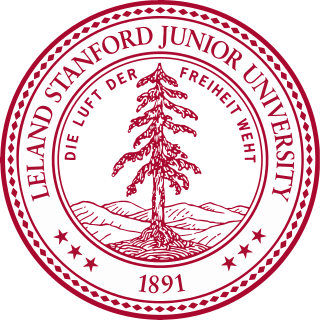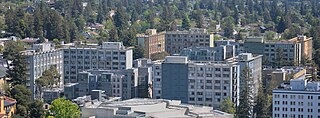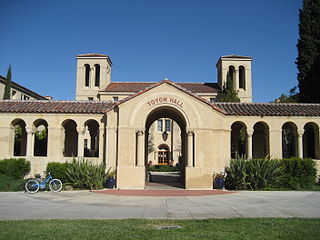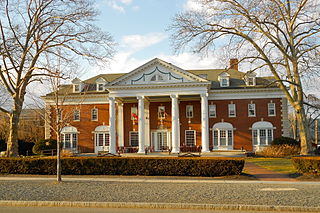
Stanford University is a private research university in Stanford, California. The campus occupies 8,180 acres, among the largest in the United States, and enrolls over 17,000 students.

California State University, Monterey Bay is a public university in Monterey County, California. CSUMB's main campus is located on the site of the former military base Fort Ord, straddling the cities of Seaside and Marina, about one mile inland from Monterey Bay along the Central Coast of California. CSUMB also has locations in the cities of Monterey and Salinas. Founded in 1994, CSUMB is part of the California State University system and is accredited by the WASC Senior College and University Commission. The university is a Hispanic-serving institution.

Fitchburg State University is a public university in Fitchburg, Massachusetts. It has 3,421 undergraduate and 1,238 graduate/continuing education students, for a total student body enrollment of 4,659. The university offers undergraduate and graduate degrees in 25 academic disciplines. The main campus, the McKay Campus School, and athletic fields occupy 79 acres (320,000 m2) in the city of Fitchburg; the biological study fields occupy 120 acres (490,000 m2) in the neighboring towns of Lancaster, Leominster, and Lunenburg.

Kentucky Wesleyan College (KWC) is a private Methodist college in Owensboro, Kentucky. Fall 2018 enrollment was 830 students.

Oxford College of Emory University is a residential college of Emory University, a private research university in Atlanta, Georgia. Oxford College is located in Oxford and specializes in the foundations of liberal arts education. The college is located on Emory University's original campus 38 miles (61 km) east of Emory's current Atlanta campus. Students who enroll in Oxford College complete an associate of the arts degree there, after which they can continue their studies at Emory's Atlanta campus to pursue a bachelor degree without any additional applications.

The Kiski School is an independent, college-preparatory boarding school in Saltsburg, Pennsylvania, United States. The school, named after the nearby Kiskiminetas River, is located about 30 miles (48 km) east by north of Pittsburgh, Pennsylvania. Founded in 1888, Kiski is the oldest remaining non-military all-boys boarding school in the United States.

Balch Hall is the only remaining all-female residence hall on the North Campus of Cornell University. Originally, Balch Hall consisted of four eighty-student halls, hence the more former name the Balch Halls, which has fallen out of use. Balch Hall is open only to female freshman and is divided into sections, known as units, each with a Residential Advisor who helps the new students acclimate themselves with the campus. Prior to the 2021-2024 renovations, the building was known for its old fashioned design as each room has a personal sink, or shares a sink with one other room.

Housing at the University of California, Berkeley, includes student housing facilities run by the office of Residential and Student Service Programs (RSSP). Housing is also offered by off-campus entities such as fraternities and sororities and the Berkeley Student Cooperative (BSC).

The campus housing system at the University of Michigan in Ann Arbor, referred to as University Housing, provides living accommodations for approximately 10,000 undergraduate and graduate students. There is no requirement for first-year students to live in University Housing, yet approximately 97% of incoming students choose to do so. Every year, over 9,500 undergraduate students are housed in 18 residence halls on Central Campus, the Hill Neighborhood, and North Campus. Undergraduates, graduate students, and students with families can live in University Housing apartments in the Northwood Community on North Campus. Seven full-service dining halls as well as several retail shops provide students with daily dining options.

North Campus is a mostly residential section of Cornell University's Ithaca, New York, campus, comprising the neighborhoods located north of Fall Creek. All freshmen are housed on North Campus as part of Cornell's common first-year experience and residential initiatives.
The University of Kentucky offers a variety of choices to students. The choices range from a number of dining options, residence halls, and athletic facilities to student organizations, religious groups, Greek-letter organizations, and intramural competitions/campus recreation.
Student housing at the University of California, Irvine, is separated between first-year students, continuing students, graduate students, and faculty. These accommodations serve the traditional purpose of housing residents and serve as a long-term outreach incentive for first-year students and faculty. Student housing also plays a crucial role in developing campus-wide social activities.
Washington University in St. Louis has varied programs and events for students.

Toyon Hall is an upperclassman dormitory at Stanford University. Its Romanesque and Mediterranean Revival Style residence halls originally housed 150 men, but today Toyon is a co-ed dorm housing 158 residents. Each of its three floors is co-ed, and most rooms are two-room doubles.
A dining club (UK) or eating club (US) is a social group, usually requiring membership, which meets for dinners and discussion on a regular basis. They may also often have guest speakers.

The eating clubs at Princeton University are private institutions resembling both dining halls and social houses, where the majority of Princeton undergraduate upperclassmen eat their meals. Each eating club occupies a large mansion on Prospect Avenue, one of the main roads that runs through the Princeton campus, with the exception of Terrace Club which is just around the corner on Washington Road. This area is known to students colloquially as "The Street". Princeton's eating clubs are the primary setting in F. Scott Fitzgerald's 1920 debut novel, This Side of Paradise, and the clubs appeared prominently in the 2004 novel The Rule of Four.

Rutgers University–New Brunswick is one of three regional campuses of Rutgers University, a public land-grant research university consisting of four campuses in New Jersey. It is located in New Brunswick and Piscataway. It is the oldest campus of the university, the others being in Camden and Newark. The campus is composed of several smaller campuses that are large distances away from each other: College Avenue, Busch, Livingston,Cook, and Douglass, the latter two sometimes referred to as "Cook/Douglass", as they are adjacent to each other. Rutgers–New Brunswick also includes several buildings in downtown New Brunswick. It is classified among "R1: Doctoral Universities – Very high research activity". The New Brunswick campuses include 19 undergraduate, graduate, and professional schools. The New Brunswick campus is also known as the birthplace of college football.

A fraternity or fraternal organization is an organization, society, club or fraternal order traditionally of men associated together for various religious or secular aims. Fraternity in the Western concept developed in the Christian context, notably with the religious orders in the Catholic Church during the Middle Ages. The concept was eventually further extended with medieval confraternities and guilds. In the early modern era, these were followed by fraternal orders such as Freemasons and Odd Fellows, along with gentlemen's clubs, student fraternities, and fraternal service organizations. Members are occasionally referred to as a brother or – usually in a religious context – frater or friar.
Since the founding, Stanford University has provided on-campus housing for students. Today, all undergraduate students, most graduate students, and many graduate employees use campus housing. While not all graduate students are eligible for campus or subsidized off-campus housing, of those that are, only 64% are able to take advantage of this opportunity due to the limited housing stock. Student Housing at Stanford is currently part of Residential & Dining Enterprises, an in-house standalone vendor within the Stanford affiliated network of businesses.

Harris Dining Hall – also known simply as Harris Hall- was named after Andrew Lintner Harris and was one of the many dining facilities located on the campus at Miami University in Oxford, Ohio. Since 1961, it was the main all-you-can-eat dining hall for undergraduate students who live on the southern side of the campus. The dining hall was closed after the spring semester of the 2016/2017 school year and it is unknown whether it will reopen. Harris was designed like most other buildings on campus in red brick and with a Georgian Revival architectural style.














